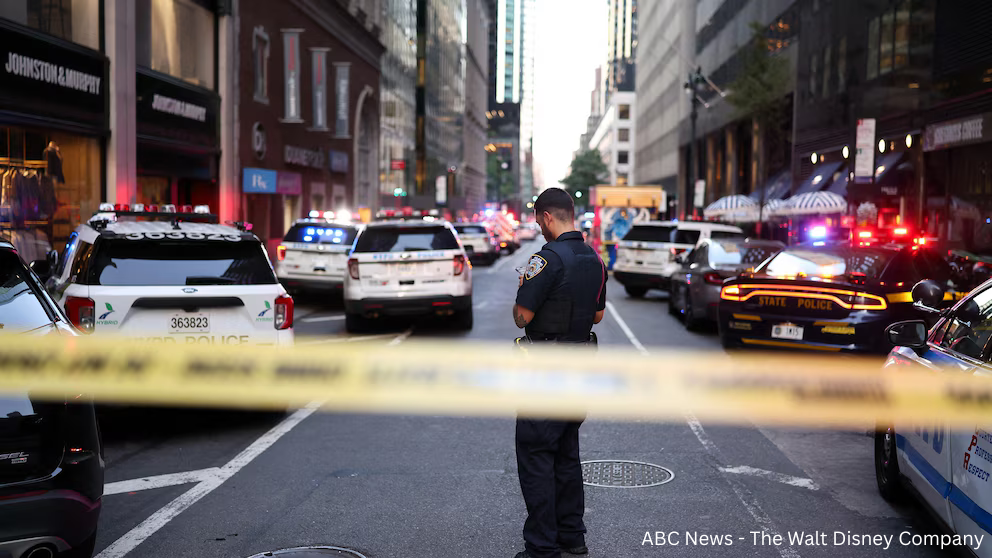As President Donald Trump pushes for a military-style crackdown on crime across American cities, New York City has quietly recorded one of its safest years in modern history. Newly released NYPD data shows shootings, murders, robberies, and other major crimes falling to record or near-record lows, even as the administration insists that urban areas are “war zones” in need of federal intervention.
This sharp contrast between political rhetoric and police-reported outcomes raises questions about how crime should be measured, interpreted, and addressed in the United States.
Trump’s Call for a Military Response
In recent weeks, President Trump has repeatedly framed urban crime as an existential threat to the nation, telling a gathering of senior military commanders that cities like New York, San Francisco, Los Angeles, and Chicago are “very unsafe places.” He went further, describing crime as a “war from within,” suggesting it requires a military-style response.
Trump has already deployed National Guard troops to Los Angeles, Washington, D.C., and Portland, with vows to extend these interventions to other major cities “one by one.” His comments underscore a central theme of his broader political strategy: portraying Democratic-led cities as dangerous and in need of federal oversight.
Yet, at the same moment these words were being delivered, New York City’s latest crime data painted a different picture—one not of rising chaos, but of historic declines.
Record-Low Shootings and Violence
According to figures released by the NYPD, citywide shootings are down more than 20% during the first nine months of 2025 compared with the same period in 2024. In total, officers recorded 553 incidents this year compared to 693 last year. For the third quarter alone, shootings dropped 15.6%, from 256 incidents to 216—the lowest figure ever recorded for that timeframe.
These statistics mark a milestone: the fewest shootings in any third quarter in New York’s recorded history. Police leaders attribute the trend in part to nightly foot patrols concentrated in high-crime neighborhoods, housing projects, and subway stations.
Police Commissioner Jessica Tisch highlighted the department’s “precision policing” model as the driving force behind the reductions.
“The NYPD’s precision policing has delivered record-low shooting incidents and victims over the last nine months, and the safest quarter ever on our subways,” Tisch said in a statement. “This is not a coincidence—it’s the result of an unprecedented, data-driven deployment of thousands of officers to the areas they are needed most.”
Homicides, Robberies, and Other Crimes in Decline
Beyond shootings, the city reported across-the-board decreases in major categories of violent and property crime:
- Murders dropped by more than 17% year-to-date, from 293 in 2024 to 241 in 2025. For the third quarter alone, homicides fell 17.5%, marking the second-lowest level in city history.
- Burglaries fell by nearly 4% for the year and more than 9% in the third quarter, bringing totals to levels not seen since historical record-keeping began.
- Robberies declined nearly 10% year-to-date and over 5% in the third quarter, another sign of sustained public safety improvements.
- Sexual assaults recorded a 13% drop even after the state expanded its legal definition of rape and sexual assault in January 2024, making the decrease especially notable.
Combined, these reductions suggest that New York City is not experiencing the surge in violent crime that national rhetoric might imply. Instead, it appears to be on track for one of its safest years in decades.
Politics Versus Data
The disparity between New York City’s local reality and the national political narrative illustrates a larger tension: crime statistics are often weaponized for political ends. While Trump warns of spiraling violence requiring military involvement, data in cities like New York shows the opposite trend.
Critics of federal intervention argue that deploying National Guard troops to cities where crime is already falling undermines local policing strategies and unnecessarily militarizes public safety. Supporters of Trump’s approach, however, suggest that tough rhetoric and visible federal presence deter crime and restore order in troubled areas.
Policing Strategies and Community Trust
Experts note that the NYPD’s focus on precision policing—placing officers in crime hot spots, analyzing trends through real-time data, and expanding presence in public transit—has been central to these results. Community-based outreach and targeted deployment have replaced broad, indiscriminate crackdowns, signaling a shift from past eras of policing.
Still, questions remain. Critics point out that while overall numbers are falling, certain neighborhoods continue to experience disproportionate levels of violence, suggesting that the city’s progress is uneven. Others argue that celebrating statistics risks overlooking the lived experiences of communities where safety remains fragile.
Nonetheless, the overall trajectory shows that data-driven, localized policing is reducing crime without the need for military involvement—at least in New York’s case.
The Bigger Picture
The NYPD’s announcement is more than just a set of statistics—it’s a counterpoint to one of the central debates in American politics: how to balance law enforcement, federal authority, and community-based safety efforts.
For now, the story of New York City serves as a reminder that crime trends are complex, and the realities on the ground don’t always align with national rhetoric. While political leaders frame cities as battlegrounds in a “war from within,” the numbers suggest progress that can be built upon with targeted local strategies rather than blanket federal crackdowns.





.jpg)


